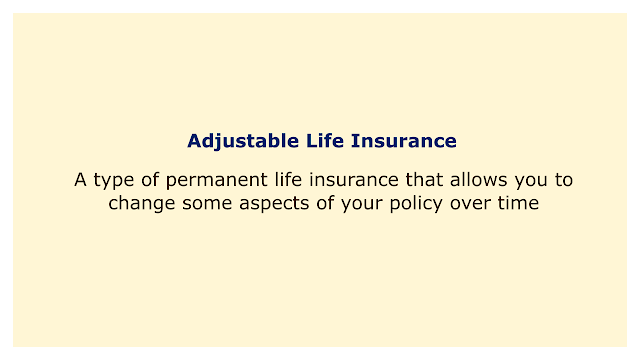 |
| Image: Moneybestpal.com |
A type of permanent life insurance called adjustable life insurance gives you the flexibility to alter some elements of your plan over time.
Adjustable life insurance offers everlasting coverage in contrast to term life insurance, which only protects you for a predetermined amount of time. It also includes a cash value component that increases tax-deferred.
The main benefit of adjustable life insurance is its flexibility. You can adjust the following features of your policy:
Adjustable life insurance is suitable for people who want permanent coverage with the option to customize their policy as their needs change. However, adjustable life insurance also has some drawbacks, such as:
There is no one size fits all when it comes to adjustable life insurance. To make sure that it satisfies your objectives and expectations, it necessitates rigorous planning and administration. You should weigh the benefits and drawbacks of each option before choosing an adjustable life insurance policy. You should also speak with a registered agent or financial advisor.
The main benefit of adjustable life insurance is its flexibility. You can adjust the following features of your policy:
- The death benefit: This is the sum of money that will be distributed to your beneficiaries upon your passing. To adjust the death benefit to your changing circumstances, such as paying off a mortgage, supporting a child's education, or leaving a legacy, you can increase or decrease the death benefit. Nonetheless, boosting the death benefit can necessitate more underwriting and more expensive premiums, while decreasing it might result in surrender fees or a decline in your cash value.
- The premium: To maintain your policy in effect, you must pay this sum of money. According to your budget and monetary worth, you can change the premium within specific bounds. The cost of insurance may be reduced by increasing the premium while the cost of insurance may be raised by decreasing it. An increase in the premium will aid in the development of more cash value.
- The cash value: This is part of your insurance plan that lets you save money and earn interest over time. Loans and withdrawals give you access to your cash value, which you can use any way you like. Your death benefit will be reduced by loans and withdrawals, and they may also result in taxes and fees. Also, you have a choice as to how your cash value is invested. You can either choose a fixed account with a guaranteed rate of return or variable subaccounts that are based on the success of the stock market.
Adjustable life insurance is suitable for people who want permanent coverage with the option to customize their policy as their needs change. However, adjustable life insurance also has some drawbacks, such as:
- Higher costs: Due to its permanent coverage and cash value feature, adjustable life insurance is more expensive than term life insurance. Also, you must pay administrative costs, mortality fees, and investing costs, all of which can lower your cash value and returns.
- Complexity: Adjustable life insurance is more complicated than term life insurance because it involves multiple variables and choices that affect your coverage and costs. Regular policy monitoring is required, and any necessary revisions must be made. This may call for additional paperwork and professional assistance.
- Risks: You run some risks when you purchase adjustable life insurance, including the possibility of losing your coverage if you don't pay your premiums on time, losing your cash value if you cancel your policy before it matures, or losing your returns in the event of a weak market.
There is no one size fits all when it comes to adjustable life insurance. To make sure that it satisfies your objectives and expectations, it necessitates rigorous planning and administration. You should weigh the benefits and drawbacks of each option before choosing an adjustable life insurance policy. You should also speak with a registered agent or financial advisor.
